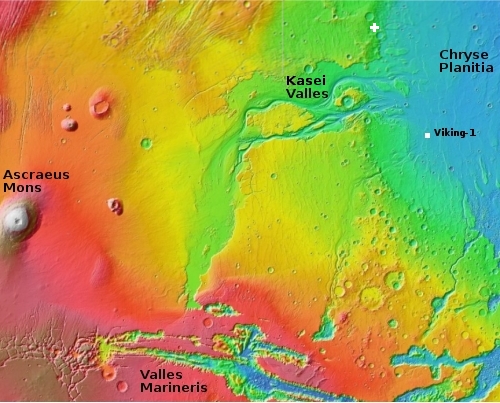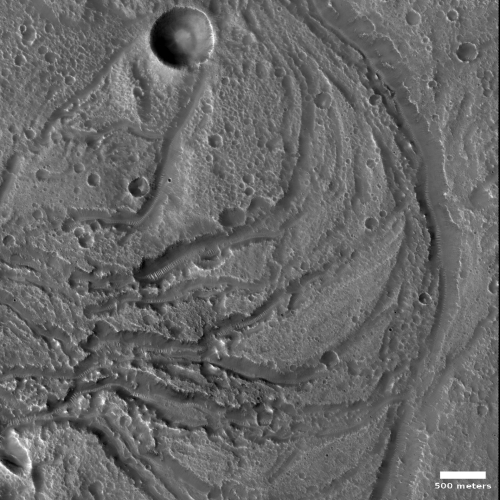An ancient curving channel on Mars
Cool image time! The photo to the right, rotated, cropped, and reduced to post here, was taken by the wide angle context camera on Mars Reconnaissance Orbiter (MRO) in April 2019. It shows an area on Mars where a number of meandering curving channels flow downhill from the west to the east.
Earlier MRO images had already spotted these channels, so when this context image was taken the scientists also took a high resolution image of the same channels, with the white box indicating the area covered by the rotated, cropped, and reduced image below.
Both images are today’s MRO image of the day, where the MRO team notes that “The objective of this observation is to examine a complex network of channels. Some parts of the channels are quite curved.”

What can they glean from these images? First, look closely at the craters in the high resolution image to the right. You will see that while the channels have cut through some craters, other craters have clearly impacted the channels after they were formed.
In other words, these channels have been here for quite awhile, many millions of years and possibly more than a billion. The scientists can in fact date the channels roughly based on their present estimate of the impact rate on Mars. By counting the total number of craters and comparing the numbers that occurred before and after the channels, they can establish a approximate age for the channels.
The latitude of the image, 36 degrees north, tells us more. While the channels themselves appear to be clean bedrock with some dust and dunes within, the large crater in the northeast quadrant of the context camera image above appears to be filled with glacial material. Ice thus has played a part in carving these channels.
The overview map to the right also gives a clue. These channels, marked by the white cross, are about 150 miles north of Kazei Valles, which scientists believe was formed by a combination of catastrophic floods, glacial processes, and a fast lava flow that washed through the already carved canyon. All three processes also probably contributed to the formation of these curved channels, though I suspect the first two dominated.
One last intriguing detail: In the wider context camera picture it appears that the flow originally headed more or less straight downhill, rather than curving sharply to the north before turning to the east. At some point the flow was forced sideways to form its present very striking meander. Why is of course another mystery that needs solving.
On Christmas Eve 1968 three Americans became the first humans to visit another world. What they did to celebrate was unexpected and profound, and will be remembered throughout all human history. Genesis: the Story of Apollo 8, Robert Zimmerman's classic history of humanity's first journey to another world, tells that story, and it is now available as both an ebook and an audiobook, both with a foreword by Valerie Anders and a new introduction by Robert Zimmerman.
The print edition can be purchased at Amazon or from any other book seller. If you want an autographed copy the price is $60 for the hardback and $45 for the paperback, plus $8 shipping for each. Go here for purchasing details. The ebook is available everywhere for $5.99 (before discount) at amazon, or direct from my ebook publisher, ebookit. If you buy it from ebookit you don't support the big tech companies and the author gets a bigger cut much sooner.
The audiobook is also available at all these vendors, and is also free with a 30-day trial membership to Audible.
"Not simply about one mission, [Genesis] is also the history of America's quest for the moon... Zimmerman has done a masterful job of tying disparate events together into a solid account of one of America's greatest human triumphs."--San Antonio Express-News
Cool image time! The photo to the right, rotated, cropped, and reduced to post here, was taken by the wide angle context camera on Mars Reconnaissance Orbiter (MRO) in April 2019. It shows an area on Mars where a number of meandering curving channels flow downhill from the west to the east.
Earlier MRO images had already spotted these channels, so when this context image was taken the scientists also took a high resolution image of the same channels, with the white box indicating the area covered by the rotated, cropped, and reduced image below.
Both images are today’s MRO image of the day, where the MRO team notes that “The objective of this observation is to examine a complex network of channels. Some parts of the channels are quite curved.”

What can they glean from these images? First, look closely at the craters in the high resolution image to the right. You will see that while the channels have cut through some craters, other craters have clearly impacted the channels after they were formed.
In other words, these channels have been here for quite awhile, many millions of years and possibly more than a billion. The scientists can in fact date the channels roughly based on their present estimate of the impact rate on Mars. By counting the total number of craters and comparing the numbers that occurred before and after the channels, they can establish a approximate age for the channels.
The latitude of the image, 36 degrees north, tells us more. While the channels themselves appear to be clean bedrock with some dust and dunes within, the large crater in the northeast quadrant of the context camera image above appears to be filled with glacial material. Ice thus has played a part in carving these channels.
The overview map to the right also gives a clue. These channels, marked by the white cross, are about 150 miles north of Kazei Valles, which scientists believe was formed by a combination of catastrophic floods, glacial processes, and a fast lava flow that washed through the already carved canyon. All three processes also probably contributed to the formation of these curved channels, though I suspect the first two dominated.
One last intriguing detail: In the wider context camera picture it appears that the flow originally headed more or less straight downhill, rather than curving sharply to the north before turning to the east. At some point the flow was forced sideways to form its present very striking meander. Why is of course another mystery that needs solving.
On Christmas Eve 1968 three Americans became the first humans to visit another world. What they did to celebrate was unexpected and profound, and will be remembered throughout all human history. Genesis: the Story of Apollo 8, Robert Zimmerman's classic history of humanity's first journey to another world, tells that story, and it is now available as both an ebook and an audiobook, both with a foreword by Valerie Anders and a new introduction by Robert Zimmerman.
The print edition can be purchased at Amazon or from any other book seller. If you want an autographed copy the price is $60 for the hardback and $45 for the paperback, plus $8 shipping for each. Go here for purchasing details. The ebook is available everywhere for $5.99 (before discount) at amazon, or direct from my ebook publisher, ebookit. If you buy it from ebookit you don't support the big tech companies and the author gets a bigger cut much sooner.
The audiobook is also available at all these vendors, and is also free with a 30-day trial membership to Audible.
"Not simply about one mission, [Genesis] is also the history of America's quest for the moon... Zimmerman has done a masterful job of tying disparate events together into a solid account of one of America's greatest human triumphs."--San Antonio Express-News




Cool puzzle time !
“At some point the flow was forced sideways to form its present very striking meander. Why is of course another mystery that needs solving.”
It appears as if the flow dropped into a (primary?) flow route previously established ?